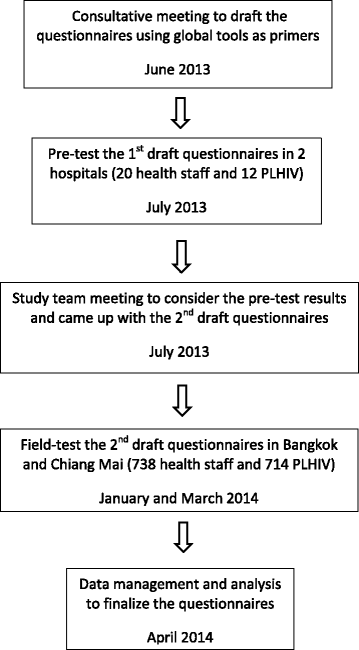Building the evidence base for stigma and discrimination-reduction programming in Thailand: development of tools to measure healthcare stigma and discrimination
- PMID: 28284184
- PMCID: PMC5346237
- DOI: 10.1186/s12889-017-4172-4
Building the evidence base for stigma and discrimination-reduction programming in Thailand: development of tools to measure healthcare stigma and discrimination
Abstract
Background: HIV-related stigma and discrimination (S&D) are recognized as key impediments to controlling the HIV epidemic. S&D are particularly detrimental within health care settings because people who are at risk of HIV and people living with HIV (PLHIV) must seek services from health care facilities. Standardized tools and monitoring systems are needed to inform S&D reduction efforts, measure progress, and monitor trends. This article describes the processes followed to adapt and refine a standardized global health facility staff S&D questionnaire for the context of Thailand and develop a similar questionnaire measuring health facility stigma experienced by PLHIV. Both questionnaires are currently being used for the routine monitoring of HIV-related S&D in the Thai healthcare system.
Methods: The questionnaires were adapted through a series of consultative meetings, pre-testing, and revision. The revised questionnaires then underwent field testing, and the data and field experiences were analyzed.
Results: Two brief questionnaires were finalized and are now being used by the Department of Disease Control to collect national routine data for monitoring health facility S&D: 1) a health facility staff questionnaire that collects data on key drivers of S&D in health facilities (i.e., fear of HIV infection, attitudes toward PLHIV and key populations, and health facility policy and environment) and observed enacted stigma and 2) a brief PLHIV questionnaire that captures data on experienced discriminatory practices at health care facilities.
Conclusions: This effort provides an example of how a country can adapt global S&D measurement tools to a local context for use in national routine monitoring. Such data helps to strengthen the national response to HIV through the provision of evidence to shape S&D-reduction programming.
Figures
References
-
- AVERT . HIV and AIDS in Thailand. 2015.
-
- IHPP . Analysis of National AIDS Program (NAP) data. Bangkok: National Health Security Office of Thailand; 2013.
-
- The Thai Working Group on HIV/AIDS Projections . The Asian Epidemic Model (AEM) Projections for HIV/AIDS in Thailand: 2005–2025. Bangkok: The Analysis and Advocacy Project, Family Health International (FHI) and Bureau of AIDS, TB and STIs, DDC, MOPH, Thailand; 2008.
-
- Alvarez-Uria G, Pakam R, Midde M, Naik PK. Entry, retention, and virological suppression in an HIV cohort study in India: description of the cascade of care and implications for reducing HIV-related mortality in low-and middle-income countries. Interdiscip Perspect Infect Dis. 2013. http://dx.doi.org/10.1155/2013/384805. - PMC - PubMed
MeSH terms
Grants and funding
LinkOut - more resources
Full Text Sources
Other Literature Sources
Medical


